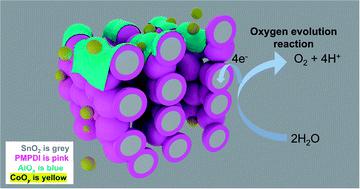当前位置:
X-MOL 学术
›
Sustain. Energy Fuels
›
论文详情
Our official English website, www.x-mol.net, welcomes your
feedback! (Note: you will need to create a separate account there.)
Ultrathin alumina passivation for improved photoelectrochemical water oxidation catalysis of tin oxide sensitized by a phosphonate-functionalized perylene diimide first without, and then with, CoOy
Sustainable Energy & Fuels ( IF 5.0 ) Pub Date : 2021-09-22 , DOI: 10.1039/d1se00908g Carly F. Jewell 1 , Ashwanth Subramanian 2 , Chang-Yong Nam 2, 3 , Richard G. Finke 1
Sustainable Energy & Fuels ( IF 5.0 ) Pub Date : 2021-09-22 , DOI: 10.1039/d1se00908g Carly F. Jewell 1 , Ashwanth Subramanian 2 , Chang-Yong Nam 2, 3 , Richard G. Finke 1
Affiliation

|
Previously, a photoanode composed of nanostructured SnO2 coated with the perylene diimide dye N,N′-bis(phosphonomethyl)-3,4,9,10-perylenediimide (PMPDI) plus photoelectrochemically deposited cobalt oxide (CoOy) was shown to photoelectrochemically oxidize water at 31 ± 7% faradaic efficiency. A non-ideal part of that prior system is that the addition of the known CoOy water oxidation catalyst (WOC) resulted in a reduction of the total photocurrent rather than the anticipated increase, due to an increase in charge-carrier recombination. Herein, we show deposition of an ultrathin alumina overlayer applied by atomic layer deposition (ALD) on the SnO2/PMPDI photoanode can improve the photoactivity and catalytic activity of the system; the addition a ca. 1 nm-thick AlOx layer deposited on a 4000 nm (i.e., 4 micron) thick mesoporous anode system can and does have a positive, 2.5-fold improvement in the steady-state photocurrent with 29 ± 9% faradaic efficiency vs. the control anode without alumina passivation by reducing charge-carrier recombination. Moreover, ALD-deposited AlOx layer does help support the understanding of the “anti-catalysis” of co-depositing a CoOy WOC on the SnO2/PMPDI DS-PECs—specifically the picture of direct CoOy–SnO2 contact-mediated recombination—but that AlOx layer was unable to improve the photocurrent in a net SnO2/PMPDI/AlOx(/CoOy) system. We attribute the lack of a performance enhancement by CoOy WOC to incomplete coverage of each SnO2 nanoparticle by the AlOx. Overall, we find the addition of an optimized ultrathin AlOx layer (0.6 nm thick; deposited at 85 °C) improves the SnO2/PMPDI/AlOx system's photoactivity by a factor of up to ca. 3-fold with reduced recombination. These results document that metal-oxide passivation by low-temperature ALD can be an effective strategy for improving the water oxidation performance of even nanostructured dye sensitized-photoelectrochemical cell.
中文翻译:

用于改进光电化学水氧化催化的超薄氧化铝钝化由膦酸酯官能化苝二亚胺敏化的氧化锡首先不使用 CoOy,然后使用 CoOy
以前,由涂有苝二酰亚胺染料N , N '-双(膦酰基甲基)-3,4,9,10-苝二亚胺 (PMPDI)的纳米结构 SnO 2组成的光阳极加上光电化学沉积的氧化钴 (CoO y ) 显示出光电化学以 31 ± 7% 法拉第效率氧化水。该现有系统的一个非理想部分是,由于电荷载流子复合的增加,添加已知的 CoO y水氧化催化剂 (WOC) 导致总光电流减少而不是预期的增加。在此,我们展示了通过原子层沉积 (ALD) 在 SnO 2上沉积超薄氧化铝覆盖层/PMPDI光阳极可以提高体系的光活性和催化活性;添加一个ca。沉积在 4000 nm(即4 微米)厚的介孔阳极系统上的1 nm 厚的 AlO x层可以并且确实在稳态光电流方面具有 2.5 倍的积极改善,与对照相比,法拉第效率提高了 29 ± 9%通过减少电荷载流子复合,没有氧化铝钝化的阳极。此外,ALD 沉积的 AlO x层确实有助于理解在 SnO 2 /PMPDI DS-PEC上共沉积 CoO y WOC的“反催化” ——特别是直接 CoO y –SnO 2的图片接触介导的复合——但该 AlO x层无法改善净 SnO 2 /PMPDI/AlO x (/CoO y ) 系统中的光电流。我们将 CoO y WOC缺乏性能增强归因于 AlO x对每个 SnO 2纳米颗粒的不完全覆盖。总体而言,我们发现添加优化的超薄 AlO x层(0.6 nm 厚;在 85 °C 下沉积)将 SnO 2 /PMPDI/AlO x系统的光活性提高了约1 倍。3 倍,减少重组。这些结果表明,低温 ALD 的金属氧化物钝化可以是提高纳米结构染料敏化光电化学电池水氧化性能的有效策略。
更新日期:2021-09-22
中文翻译:

用于改进光电化学水氧化催化的超薄氧化铝钝化由膦酸酯官能化苝二亚胺敏化的氧化锡首先不使用 CoOy,然后使用 CoOy
以前,由涂有苝二酰亚胺染料N , N '-双(膦酰基甲基)-3,4,9,10-苝二亚胺 (PMPDI)的纳米结构 SnO 2组成的光阳极加上光电化学沉积的氧化钴 (CoO y ) 显示出光电化学以 31 ± 7% 法拉第效率氧化水。该现有系统的一个非理想部分是,由于电荷载流子复合的增加,添加已知的 CoO y水氧化催化剂 (WOC) 导致总光电流减少而不是预期的增加。在此,我们展示了通过原子层沉积 (ALD) 在 SnO 2上沉积超薄氧化铝覆盖层/PMPDI光阳极可以提高体系的光活性和催化活性;添加一个ca。沉积在 4000 nm(即4 微米)厚的介孔阳极系统上的1 nm 厚的 AlO x层可以并且确实在稳态光电流方面具有 2.5 倍的积极改善,与对照相比,法拉第效率提高了 29 ± 9%通过减少电荷载流子复合,没有氧化铝钝化的阳极。此外,ALD 沉积的 AlO x层确实有助于理解在 SnO 2 /PMPDI DS-PEC上共沉积 CoO y WOC的“反催化” ——特别是直接 CoO y –SnO 2的图片接触介导的复合——但该 AlO x层无法改善净 SnO 2 /PMPDI/AlO x (/CoO y ) 系统中的光电流。我们将 CoO y WOC缺乏性能增强归因于 AlO x对每个 SnO 2纳米颗粒的不完全覆盖。总体而言,我们发现添加优化的超薄 AlO x层(0.6 nm 厚;在 85 °C 下沉积)将 SnO 2 /PMPDI/AlO x系统的光活性提高了约1 倍。3 倍,减少重组。这些结果表明,低温 ALD 的金属氧化物钝化可以是提高纳米结构染料敏化光电化学电池水氧化性能的有效策略。









































 京公网安备 11010802027423号
京公网安备 11010802027423号